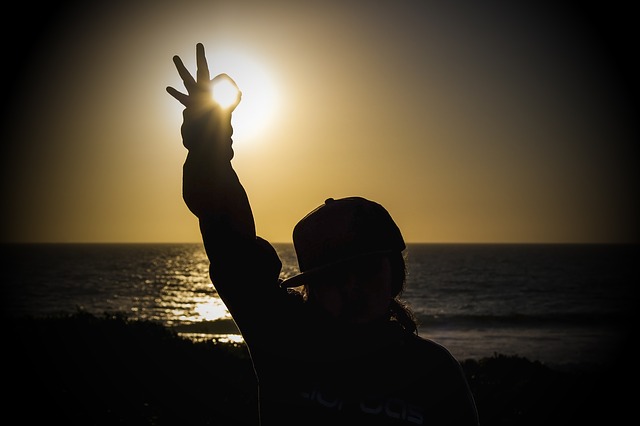What do you think of when you hear of the word love?
Maybe it’s having a romantic evening with that special person, laughing with your best friends or rocking your newborn baby to sleep. The majority of us have the tendency of considering love as a warm, fuzzy feeling that we have for the people we share close bonds with like our family, friends, and partners.
However, this is a really incomplete opinion of love, one that prevents how much happiness and joy we feel. Love is essentially about building, improving and enjoying our relationships with other people and the world that surrounds us. Because we’re eventually connected to everyone and everything, love is something we can put into all parts of our lives.
Think of how your life will be like if all waking moments held the potential for love. This may seem like a delusion or fantasy; however, it is really something all of us can attain with simple day-to-day routines. With cases taken from the lives of the author, her friends, as well as her students, Real Love will assist you to find how to form deeper love connections.

Chapter 1 – The stories share about our lives have an important influence on how we view ourselves either for better or for worse.
No one understands our lives more than we actually do, right? Therefore, the stories we tell about our experiences will be honest explanations. Well, that’s not the case actually. No one is trustworthy narrators, regardless of the person’s life we’re talking about – not even our own.
Our brains regularly try to make sense of the incidences that occur in our lives, filling any holes just to form cohesive stories. These stories are really powerful that we think they must be correct; however, they’re regularly deceptive. For example, a child bitten by a dog might think that every dog is aggressive. This story will form a lifelong fear of the entire dog he meets.
Not only do these faulty stories form how we view the world around us; however, they can also unconsciously affect how we see ourselves. For instance, when Diane’s fiancé called off their engagement, she let go of her own severe doubts about the relationship and decided that she was “unlovable.” This story of unlovability was one Diane had been saying to herself since she was a child, therefore, it felt reasonable to her that she was the main cause for the failure in her relationship.
Also, the stories other people say of our lives affect how we view ourselves. From their words and deeds, our family members and friends can meaningfully form our behaviors toward ourselves.
This is the feeling Gus experienced as a child. Gus had four unruly brothers, and his love for books and music categorized him as different in his roughhousing, outdoorsy Montana family. His hate for their passions – camping, hunting, and fishing –signified that his family members regularly disappointed him.

Fortunately, Gus also felt the positive effect stories can have. His uncle Don discovered value in his sensitivity and would defend Gus, saying he was gifted. Gradually, Gus’s family started to celebrate his uniqueness, which enabled Gus to accept who he was.
Once we understand that we can all be defective narrators –regardless of whether we’re saying stories about ourselves or others – we can concentrate on the side from which we’re saying our stories. For instance, recall Diane’s story of being unlovable? She was able to recognize it and then restructure it into a healthier story by nurturing mindfulness and self-compassion, which we will see in the later chapters.
Chapter 2 – In order for us to be happy eventually, we have to first engage with difficult emotions.
We’ve all experienced this, keeping a lid on anger, frustration or hurt until we blow up. However, suppressing difficult emotions restricts our emotional experiences and allows us to be more miserable.
It may look counter-intuitive; however, when we don’t completely interact with emotions that are uncomfortable or painful, we extend our suffering instead of avoiding it. Author Sharon Salzberg was reminded of this when her close friend committed suicide. In a meditation retreat, Salzberg restrained the severity of her grief because she was unwilling to deal with it. The monk that was directing the retreat was surprised by this, telling her to let go of her feelings by crying wholeheartedly. When she discovered the courage to do this, Salzberg didn’t feel trapped by her sadness anymore.
It wasn’t only Salzberg’s grief that hindered her from experiencing her feelings openly at the retreat. She was embarrassed to acknowledge her sadness for a role model she respected. Just like Salzberg, when we experience difficult feelings like shame, we regularly become isolated since we feel really vulnerable to share our stories. The voice in our head says to us that we’re undeserving of love since we’re defined just by the cause of our shame. Even when that cause is not in our control, shame can still have power in our lives.

For instance, while Patty was still a child, she had feelings of worthlessness that became dominant in her identity. She lived in fear that her classmates would discover that her parents were alcoholics and then bully or reject her due to that. Keeping this as a secret was a very bad weight that destroyed Patty’s self-esteem, despite the fact that she was a good student and devoted to her friends.
It isn’t easy, however, we can move past difficult emotions by admitting and exploring them instead of telling ourselves to “forgive and forget.” With meditation and mindfulness practices, we can connect with our emotional wounds – a vital milestone on the journey to forgiveness. Once we’ve gotten to forgiveness, we will be free to feel love and joy once more, regardless of the scars we have.
For example, Salzberg got a lot of emotional scars during childhood. When she turned nine, Salzberg had lost both of her parents to death and absence. She felt abandoned. While she was meditating one day, her childhood loneliness drowned her. However, instead of suppressing it, she accepted that this single feeling didn’t shape her since she still had the ability of immense love. That realization enabled her to see her parents with compassion and forgiveness.
Difficult feelings are an unavoidable part of the human experience. When we admit and accept this, we can reconnect with others and foster self-love.
Chapter 3 – An open and plainly playing field is the greatest place for getting real love.
Let’s assume you’re having coffee with your partner, and she’s unfocused. A voice in your head says you she’s lost interest in you, that soon enough, she will fall out of love. And you trust this voice without any doubt.
Mostly in relationships, we don’t openly say what we mean or feel; therefore our loved one has to fill in the gaps themselves. So, if our loved one doesn’t do a little consideration at first, they may innocently fill those gaps with destructive misinterpretation.
We have to practice kindness to ourselves as well as to others in order to counteract our damaged gap-filling. Kindness reminds us that we’re worthy and tells us to think of other stories. For instance, your partner might be unfocused because she’s bothered about a downsize at work – something that doesn’t have to do with you at all! Rather than behaving from a place of hurt, you can reach out to her from a place of kindness and ask her if everything is alright. This would dismiss your negative self-talk and your partner will feel more supported, encouraging a loving connection.
Let’s look at the studies done by the Gottman Institute, a Washington State-based organization committed to knowing about healthy relationships. Researchers discovered that kindness is really the most precise sign of how successful a marriage will be.
According to Julie Gottman, the institute’s co-founder, practicing kindness is most valuable during times of conflict since it prevents us from attacking our partners. Although it’s essential to recognize our anger, we can decide to show it in a constructive manner, like telling our partner the reason we are hurt rather than attacking them.

However, it needs a vast, conscious effort to behave with self-control during the conflict, particularly if we’re used to being defensive. And regularly what makes us really defensive is our conviction that we recognize what’s fair.
In order to have long-lasting relationships, we need to reassess our ideas of fairness with what Salzberg refers to as a “willingness to begin again.” In order to attain this, both we, as well as our partner, need to stop keeping score and begin to become aware that there may be various methods to solve a certain conflict. By knowing that we’re “co-sponsoring” each other, we start to view the relationship as a means to make life better for ourselves as well as our partner. And this forms a sense of a loving partnership –instead of competition – filled with mutual support.
Chapter 4 – What we do with the gap between us and our loved ones extremely disturbs our happiness.
Let’s say you’re sitting in the car, sweltering because your partner has increased the heat really high. Rather than reducing it, you say to yourself that your partner’s comfort is more significant than yours. However, you can feel your anger developing.
In circumstances such as that, you’re facing one of the greatest challenging parts of any close relationship: navigating the gap that occurs between us and our loved one. That gap can be precise, like a car interior; however, it can also be really figurative: the emotional gap produced by our individual desires and vulnerabilities.
Regularly, we occupy this gap with what we believe our partner needs. For example, Bill tried to close the gap between him and his wife by being engaged in all the things she did. When she needed to go for a three-month vacation with her sister, he understood his overinvolvement in her life occurred from his own desires and not hers. He wasn’t excited about her vacation and said so to her; however, he accepted her decision. His honesty, together with her gratitude, strengthened their love.
Also with the case of Bill, filling our relationship gaps with positive feelings causes personal development and deeper connections. However, unfortunately, these gaps regularly turn into battlegrounds.

John and Julie Gottman both psychologists and the founders of the Gottman Institute – have used 40 years studying couples. They discovered that couples who react to fight with negative deeds such as criticism or defensiveness were not just sad; however, they were also less healthy since they felt higher physical tension.
This didn’t signify that happy couples were avoiding fights. Instead of avoiding it, they intentionally approached differences of view with the notion that their partner had good motives overall. This signified that they could react without attack or mockery, forming what the Gottmans refer to as emotional safety. As a result of a couple’s level of emotional safety, the Gottmans could calculate with an amazing 90% accuracy how successful a relationship would be.
Since we are people with difficult needs that are deeply influenced by our fears, there will regularly be a gap between us and others. However, navigating this gap in the spirit of honesty and kindness allows us to love with less fear and to honor our personal desires.
Chapter 5 – In order to form a deep connection with someone, we have to let go of our expectations.
Over time, the majority of us like to consider ourselves as superheroes, jumping in to mend the broken hearts, minds or bodies of loved ones. However, is this really helpful or are we only interfering in their issues?
Even when we have their best interest at heart, attempting to “fix” someone who’s sick or emotionally injured can be counterproductive. The reason is that it puts stress on our loved one to live up to our expectations in order for them not to let us down. Also, a lot of people are bothering them with ideas on how to get better, and stress doesn’t allow people to heal.
However, this doesn’t signify that we should disappear when our loved one is suffering. When a close friend of Salzberg’s got ill, one of her teachers suggested that she should only “be with” her friend. Fighting the desire to give unwanted advice and basically being present is regularly exactly what a vulnerable loved one requires.
Freeing ourselves from our own expectations helps us as well. Regularly, we’re really resolute to keep our self-sufficiency that we hinder ourselves from getting love. Assuming that we can be and do everything puts us under huge pressure and removes our connections to others in the times when we need it.
For instance, when Sebene was diagnosed with cancer during mid-thirties, she spent massive amounts of energy in displaying people how well she was surviving. However, when her sickness deteriorated, Sebene was enforced to free her idea that she was superhuman. When she requested for assistance, she offered her family and friends the opportunity to show their love through acts of support. This made their emotional connections deeper.

Just like Sebene, a lot of us nurture unrealistic fantasies about ourselves. However, we also have the same fantasies about other people, which form a gap between us and them. This happens particularly in relation to what Jungian psychologist James Hollis refers to as “Magical Other” – that one and only person who will heal us and complete us.
However, this ideal other doesn’t occur outside of movies and novels. When we stop expecting that another person will make us complete, we will not just take charge of our own healing; however, we will also understand other people’s wounds more. This understanding makes our connections with others deeper, causing mutually satisfying relationships.
Just like rain fills a dam after a drought, creating space for love entails that you are forming possibilities – for healing, getting and creating accurate connections.
Chapter 6 – We can change jealousy into joy by examining its roots.
We all feel the itch of jealousy over time. Our best friend marries someone stunning and we reason that we never will, a coworker gets the publishing deal we wish for, our yoga partner nails all pose while we struggle. We think that there’s not adequate love, opportunity or talent to go round.
But, there’s a means we can really gain from other people’s happiness through what’s known as sympathetic joy. We only have to learn how to experience it.
The first step to that is recognizing what’s hindering us from celebrating another person’s success. Observing why we’ve acted badly to another person’s good news regularly finds our own vulnerabilities. For instance, a writer might experience difficult feelings if his friend’s book gets an excellent review. But, if he used some time discovering why he feels like that, he might find that it’s because he’s insecure about his own book.
Once we’ve recognized the emotions that have initiated our jealousy, we can progress to the next step which is– exercising self-compassion. Rather than cautioning ourselves for not being happy for our friends, we need to be kind and patient with ourselves. Taking a witty method assists some people to attain this step. For instance, one of Salzberg’s friends likes to possess her difficult emotions by saying, “I’m accepting the petty within!”
After compassion has moved us to a place of self-love, we can begin practicing with sympathetic joy. For this last stage, we need to challenge the idea that the things we need are limited resources. Questioning ourselves can enable us to accomplish this; is there over one potential spouse, book deal or measure of success in the world? The answer is, usually, “Yes.”

When we open ourselves up to the notion that joy is plentiful and occurs from a lot of roots–as well as the happiness of others – we are in the actual state to feel sympathetic joy. This doesn’t just increase our own happiness; however, it also promotes strong connections with others.
For instance, Shelly Gable a professor of psychology at the University of California, Santa Barbara, observed sympathetic joy in couples in 2006. She discovered that the manner a partner reacts to the good news is really essential in keeping a healthy relationship than how they react to bad news.
Therefore, instead of dismissing our partner’s promotion as just good luck, we should open the champagne and celebrate with them in order to increase our own joy.
Chapter 7 – The strategic to forming loving connections is to actively concentrate on the people you meet and the world around you.
Let’s say you’re at the grocery store checkout, with your mind actively going through your “To Do” list, and you are stressed about it. You pay the cashier without even looking up. What you didn’t see is the bright smile he’s giving you. You’ve just lost a lot of connection.
The stresses of this current life signify that we’re regularly running on autopilot, not entirely present in the moment since we’re engrossed in our own issues. However, this signifies that we’re cheating ourselves not just of getting love but of forming it through small gestures of kindness that cost us a bit and improve our connections with others.
We don’t have to limit these acts of kindnesses to those we love. After a shattering breakup, Chloe, one of Salzberg’s student had a great breakdown on a packed Manhattan train. Cultural conditioning taught Chloe that she should be embarrassed about crying in public. However, as she got off, a stranger gave her a gentle smile and a tissue. This small gesture of compassion totally changed Chloe’s feelings. Showing kindness to others doesn’t only assist them; it also boosts our own happiness eventually.
Definitely, it’s easy to be kind to the people we love or the people we know. However, what about people we don’t like?
Regularly, we see people we don’t like through a wide lens. That is we’re not concentrating on how we’re related or how interrelated our lives actually are. And this essentially lessens our own happiness.
For example, during a dinner with the English department of a Midwestern university, a writer friend of Salzberg was enforced to challenge his pattern of unconsciously judging people. A woman he’d believed was an illiterate solely based on how old-fashioned she looked shocked him by sharing her pleasure in reading Proust in the original French. In his rush to classify her as rural – and so not like him – he’d let go the potential for shared interests or similarities.

Likewise, when we’re scared of people, we frequently judge them based on prejudices or superficial ideas. However, moving close to the person we don’t like or fear enables us to see beyond our biases and seek common ground. As an Israeli mother Robi Damelin whose son was murdered by a Palestinian sniper indicated in an article published in Haaretz, the tears of bereft Israeli and Palestinian mothers are exactly the same color and substance.
Valuing similarities over differences enables us to nurture compassion, eventually increasing everybody’s happiness.
Chapter 8 – Taking time to accept the world that surrounds us– even for one minute –allows happiness to succeed.
Have you ever seen yourself thinking that, “I’ll be happy when…”? A lot of us connect happiness with reaching a certain milestone in life such as the dream job, apartment, partner or child. However, in reality, life-changing happiness happens on a much smaller scale, and difficult emotions can assist us to reach it.
In our attempt to become happy, we regularly suppress emotions such as anger in an attempt to evade confrontation. However, this is a false bargain. If we reject our anger, we can’t let go of it and this prevents us from being happy. For instance, if we have a chaotic housemate, we might quietly rage as we still face the pile of dirty dishes he left in the kitchen. However, except we accept our frustrations, we can’t change into the mindset we require to solve our issue constructively. And taking a constructive step is the way to letting go of the rage.
But, difficult instants aren’t the consequence of someone else’s action all the time. They regularly occur when we feel that life is not as good as we thought it would be. To fight this, we need to open our hearts and accept life as an adventure, appreciating it for what it is.
For example, during an outing to Santa Fe, Salzberg discovered a stunning rainbow she wanted to photograph. However, by the time her old phone came on, the rainbow had gone. Disappointed, Salzberg criticized herself for not purchasing a new phone. However, two women walked past her and appreciated the amazing pink clouds in the sky. Salzberg was reminded to forget her disappointment and accept what was happening before her.

Experiencing this type of sensation doesn’t just connect us to the world we live in, but also supports the connections we have with others. Paul Piff and Dacher Keltner both Psychology professors did an experiment about awe and connection at the University of California. They discovered that students who’d spent time viewing some mind-blowingly tall eucalyptus trees gave more help to a passerby who’d stumbled than students who’d been viewing concrete buildings. And all it required was a minute of tree-gazing to stimulate an act of kindness to a stranger.
Remaining curious about our world, the people who live in it with us and our emotions remind us that we all are from the same diverse and interconnected web of life. If we can draw from that sense of abundance that occurs from life’s ceaseless wonders, we will be filled with joy each and every day.
Real Love: The Art of Mindful Connection by Sharon Salzberg Book Review
Love isn’t only an emotion; it is a conscious practice that every one of us can engage in daily. In order to attain this, there are some things we need to focus on: the validity of our self-talk and what other people say about us; the full spectrum of our emotions, as well as the difficult ones we’d somewhat evade; our behavior, specifically during times of struggle; our expectations, both of ourselves and of others; and the world we are, with our fellow humans. Once we know how to explore and unpack the causes of our difficult emotions with compassion and accept kindness toward ourselves and others, we can form important relationships and experience more joy on a daily basis.
Use the RAIN technique to discover difficult emotions.
When you feel difficult emotions, using the acronym RAIN can explain how you feel and soothe your suffering. The full meaning of RAIN is: Recognizing your feelings by mentioning them; Acknowledging your feelings and allowing yourself to experience them; Investigating your feelings with a spirit of curiosity; and Non-identifying with your feelings by identifying you don’t have to be shaped by them.
Download Pdf
https://goodbooksummary.s3.us-east-2.amazonaws.com/Real+Love+by+Sharon+Salzberg+Book+Summary.pdf
Download Epub
https://goodbooksummary.s3.us-east-2.amazonaws.com/Real+Love+by+Sharon+Salzberg+Book+Summary.epub
